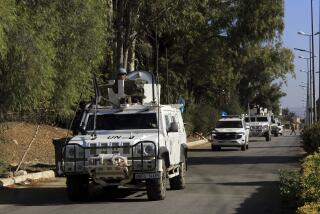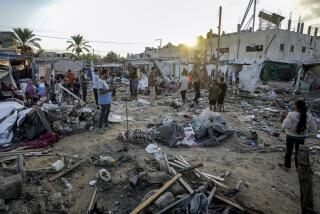Bombers Kill 38 in Iraq, Israel
BAGHDAD — A suicide bomber rammed a cement truck loaded with explosives into the U.N. headquarters here Tuesday, toppling a wing of the building in a thunderous, dust-choked roar and killing the top envoy and at least 19 other people. Scores more -- foreigners and Iraqis -- were injured.
Iraqi policemen and firefighters and American soldiers dug with their bare hands through mounds of cracked concrete in a frantic search for trapped victims.
Among those missing for hours and found dead under the debris was Sergio Vieira de Mello, the top U.N. envoy in Iraq. U.S. officials on the scene said the Brazilian diplomat may have been the intended target because the bomber struck so close to his office.
It was the first suicide bombing in Iraq since the U.S. takeover -- and the second major attack against a civilian target in Iraq this month. Violent opposition to foreign occupiers is posing an increasingly deadly, unpredictable threat to U.S. efforts to stabilize and rebuild the country.
By targeting the United Nations, a world body that did not participate in the U.S.-led war to oust Saddam Hussein, the perpetrators undermined any sense of security here and significantly broadened their guerrilla war.
The U.N. compound was a “soft” target, more vulnerable than any of the U.S. installations here. Housed in what had been the Canal Hotel, the headquarters had no protective berms and no massive U.S. military presence. In fact, many U.N. officials had been keen not to be too closely associated with the occupation.
No group initially claimed responsibility for the attack, which follows a string of assaults on oil pipelines, a water main and the Jordanian Embassy -- as well as daily hit-and-run ambushes of U.S. troops.
President Bush, speaking from his Texas ranch, branded the attackers “enemies of the civilized world” and warned that they will not “determine the future of Iraq.”
L. Paul Bremer III, the U.S. civilian administrator in Iraq, rushed to the scene of the bombing, tears in his eyes. He later condemned “the ugly face of terrorism” and said: “The people who did this attacked not the Americans, not even the coalition, not even just the Iraqis, but innocent men and women who were simply trying to make life better for the Iraqis.”
Bremer, who has said Iraqi insurgents run the gamut from members of the deposed Hussein regime to foreign mercenaries and possibly elements of the Al Qaeda terrorist network, vowed to “leave no stone unturned” to find and punish those guilty of the attack.
There was speculation that the U.N. may have been attacked because Vieira de Mello had recently expressed support for U.S. policy and the new Iraqi Governing Council.
Victims Identified
The United Nations identified seven of the dead -- all foreigners, including Richard Hooper of Walnut Creek, Calif.
Blood streaming from his right shoulder, Fawzi Hamdani managed to escape from the U.N. compound where he had been waiting in the parking lot to pick up a friend. About 300 people were working inside the converted hotel when the bomber attacked, shortly before 4:30 p.m., quitting time.
The force of the explosion collapsed an entire corner of the three-story U.N. building, its thick concrete wall flapping over like a piece of burlap, and knocked the ceiling down in a next-door hospital for patients with spinal cord injuries. Windows were blown out of homes for blocks.
Hamdani said he saw the truck that he believes carried the explosives to their mark. The driver, he said, was a young, clean-shaven man in a white T-shirt who did not emerge from the vehicle. “He was determined for this task,” Hamdani said.
The truck, described by several witnesses as a cement mixer, apparently crashed through the gate of a cinder-block wall being built to shield the compound and then plowed into a side of the building, directly below Vieira de Mello’s third-floor office.
U.S. officials described the attack as a suicide bombing that, given the size of the explosive and its devastating impact, required a level of sophistication and planning not necessarily seen in assaults before now. The U.S. military said the bomb contained 500 pounds of powerful C4 explosives.
A U.S. intelligence official said investigators had yet to identify who was responsible for detonating Tuesday’s car bomb and the one at the Jordanian Embassy 12 days earlier.
But the official, who spoke on condition of anonymity, said investigators were focusing primarily on two groups: former Baath Party regime members and a local Al Qaeda affiliate known as Ansar al Islam.
Hussein’s government, the official said, was familiar with using car bombs as terrorist weapons.
“The Iraqi intelligence service had terrorist training camps, and they certainly knew how to do these kind of explosive devices,” the official said. “That’s what they were going to use to assassinate [former President] George Bush Sr. after the Gulf War. We know that.”
Ansar al Islam was based in northern Iraq before the war. The group’s camps were destroyed, but surviving members and other militant Muslim sympathizers are now said to have reestablished contact.
“They’re still in Iraq,” the official said. “There was some intelligence last month that they were going to conduct suicide attacks against coalition forces.”
But he emphasized that neither group was yet known to have played a role in the two terrorist attacks. Evidence, he said, would come from more detailed forensic investigation of the two bombs, and whether they contained the same explosives or shared other signature characteristics.
FBI Statement
In Washington, an FBI official said: “The FBI, which already had a team of investigators in place for the Jordanian Embassy bombing, responded immediately to the blast site at the request of ambassador Bremer. Included in that team are bomb technicians, experts in document exploitation, and evidence response teams.”
Bernard Kerik, the former New York City police commissioner who is overseeing Iraq’s police force, said the investigation “is completely up to the Iraqi police service.” Speaking on ABC’s “Nightline” program, he said: “They have an investigative body that is conducting the investigation, working in conjunction with the FBI.”
Tuesday’s blast left the cement truck in flames and a crater 5 feet deep and 15 feet wide, surrounded by mounds of debris -- pieces of cars, glass and metal. One official reported seeing a drive shaft intact, probably from the bomb vehicle. Smoke visible for miles shot up from the compound, obscuring the pale-blue U.N. flag that fluttered above the scene of destruction.
The wounded lay writhing in the frontyard of the compound receiving emergency first aid. American Blackhawk and Kiowa helicopters circled above, first as a show of force and then to ferry the most seriously injured to hospitals. Other victims were evacuated in a screeching parade of ambulances that continued hours after the blast.
“There was a tremendous explosion, and I don’t know what happened after that,” Rafi Levon, a security guard at the U.N., said later from a stretcher in the Al Wasiti hospital, where overworked physicians applied antiseptic fluid to his wounds and used tweezers to pull shards of glass from his body.
Next to him lay Wasan Muafwaq, a 25-year-old worker at the cafeteria -- a popular meeting place for U.N. diplomats, American military officers and journalists.
“I felt like I was going to be thrown out the window,” she said, her hands swathed in bandages and gauze strips covering the cuts on her face. Her relatives bemoaned the lack of security in occupied Iraq.
“We didn’t care for Saddam, but at least it was secure then,” said Muafwaq’s cousin Mohammed Hassan.
When the bomb exploded, a news conference was taking place inside the building. Journalists were hurled against the wall and to the floor as the conference room was plunged into darkness and filled with screams and the sounds of shattering glass.
Bloodied, cut and covered in white dust, the journalists staggered from the building, stepping over bodies in some places.
Desperate Relatives
Outside, as the U.S. military cordoned off the site and blocked roads, desperate relatives of Iraqis who work for the U.N. gathered, weeping and begging for news of their loved ones. “Which hospital? Which hospital?” some shouted at soldiers and Iraqi policemen.
Yasem Mohammed Saeed, an electrician, was looking for his sister, Sahera, who works in the cafeteria at the building. He never imagined that her job would be dangerous. Iraqis working with the U.S. military and occupation authority have been frequent targets, but “we thought the U.N. was very safe,” he said.
U.N. officials said Vieira de Mello, a 55-year-old veteran trouble-shooter who was also the world body’s human rights envoy, apparently survived the blast initially and even communicated by telephone with aides. Nearly four hours after the explosion, a crane was being brought in to attempt to lift a slab of concrete that lay atop Vieira de Mello’s office.
His death was announced after nightfall. U.N. Secretary-General Kofi Annan, who had personally urged Vieira de Mello to assume the problematic Baghdad post, said he was shocked and dismayed. The U.N. flag in New York was lowered to half-staff.
Two members of the Governing Council who inspected the site with Bremer condemned the violence.
“We are shocked but not surprised,” Akila Hashimi said. “This is an evil expression of these terrorists ... an attack against all of humanity.” She urged the U.N. to stay the course and continue its work in Iraq.
After the explosion, U.S. troops and foreign institutions across the capital imposed harsh security measures. The cavernous headquarters of the Coalition Provisional Authority, where hundreds are at work trying to put together an interim government, was evacuated and troops were put on heightened alert even at the high-security presidential palace housing Bremer’s operations.
“There’s concern that there is an increased threat to all CPA and U.N. activities now,” said David Hodgkinson, whose offices with the Division of Transitional Justice were among those emptied as a precautionary measure shortly after the attack. “If they did this to the U.N., who knows what else could be targeted?”
*
Wilkinson reported from Baghdad and Drogin from Washington. Times staff writers Patrick J. McDonnell and Carol J. Williams in Baghdad, Rick Schmitt in Washington and Maggie Farley at the United Nations contributed to this report.
More to Read
Sign up for Essential California
The most important California stories and recommendations in your inbox every morning.
You may occasionally receive promotional content from the Los Angeles Times.












